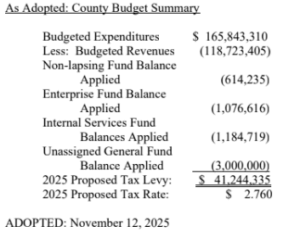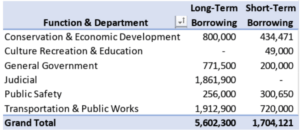November 16, 2025
A County Budget in Focus:
Priorities in community services, addressing growing debt, and expenditure shifts.


Rising costs due to inflation, overspending, and other service expenditures left a $3.9 million deficit in 2024. This is reflected in the 2026 budget, which faces a $1.8 million budget deficit (which was reported in August). One way to tackle the debt is by implementing a debt levy (or using a portion of collected property tax to pay for principal and interest on existing debt). As highlighted in the Capital Improvement Plan, the recommendation for the 2026 budget is "$7.3 million, including $1.7 million of short-term debt. The goal of structuring debt in this manner is to maintain a flat debt levy while using short-term debt to minimize interest costs." (Administrator's Recommended Budget). The recommended budget provides an overview of expenditures that are funded by debt, showing how important using debt can be to fund roads, public safety, and transportation.

Although the recommended 2026 budget saw a 6 percent increase from the previous (totaling $165.9 million), several departments were asked to develop reduction plans of up to 5 percent to balance the budget. One such department was Human Services. The Department of Human Services saw a 5 percent reduction in funding, which may impact social services (including child welfare), highlighting the challenging nature of creating a budget with limited revenue and rising expenditures.
Any successful budget is developed with the future in mind, and Eau Claire County is no different. To maintain a sustainable budget and to ensure services remain in the short and long term, a County will look towards the many communities it serves. From business owners to interested community members, it is important to understand how your budget process functions. Administrators and officials working on the budget named a few key purposes when writing a budget, namely that it reflects “the type and level of services desired by our community while recognizing the unique character of Eau Claire County” and that it “aligns with the County’s mission, vision, and goals” while providing transparency for the public. (Administrator's Recommended Budget). So, while the County may play an important role in delivering services desired by its populace, it is up to the public to advocate for their needs and understand how the budget works while living in the realities of limited revenue and growing expenditures.
Sources:
Budget Timeline, Eau Claire County
2026 Administrator's Recommended Budget, Eau Claire County
County 2026 Budget page, Eau Claire County
Business Advocate, Eau Claire Area Chamber of Commerce
Posted by Brennen Bolopue, Governmental Affairs Intern
bolopue@eauclairechamber.org
